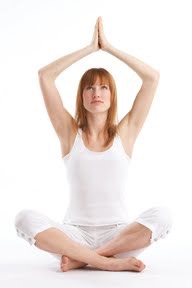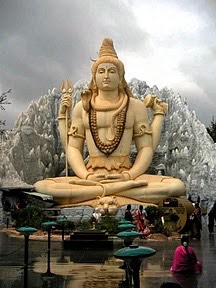 Yoga and other Eastern practices are being promoted in the Western world—and the Western Church—as tools for physical, spiritual, and even financial wellness. While the dangerous nature of these practices remain hidden, much is said about the benefits of partaking in these "body, mind, and spirit" exercises. Consider the following excerpts from leading Christian news sources.
Yoga and other Eastern practices are being promoted in the Western world—and the Western Church—as tools for physical, spiritual, and even financial wellness. While the dangerous nature of these practices remain hidden, much is said about the benefits of partaking in these "body, mind, and spirit" exercises. Consider the following excerpts from leading Christian news sources.
"The Art of Yoga" by Erika Gladden, originally published in 2009 on the Christian website GraceNotes (the article has since been removed):

If you have been looking for ways to gain strength, flexibility and good posture, stress relief as well as health benefits, then yoga might be for you.
Yoga increases our strength through the different poses that are practiced and provides muscle tone. There are different poses that work on each specific muscle in the body…
In the practice of yoga, there is a focus on our breathing. Most of us are in a hurry and don't take the time to focus for even five minutes on breathing more slowly and more steadily. Yoga also focuses on quieting our busy mind; allowing us to be in the present and focus on our breathing, pose or our balance...
The only way to know if you will receive these benefits is by trying yoga for yourself. It is recommended to try a class that lasts eight weeks long in order to gain these benefits.
"Yes to Yoga" by Agnieszka Tennant from ChristianityToday.com:
...let me witness that yoga has never had any negative influence on me, and it doesn't trigger any harmful religious impulses. Just the opposite is true. The three hours a week I spend doing yoga not only make me more flexible, tone my muscles, and relax me. They also draw me closer to Christ. They are my bodily-kinetic prayer...
I know that hard-core yogis believe that yoga is more than exercise or a relaxation technique. To them, it's a religious ritual. But the Hindu gods don't make it onto my mat. Yoga purists don't lead classes at mainstream American gyms. Could it be that some of them learned yoga from the purists? Yes. But no one's making me repeat any mantras.
In response to Tennant's article, author Roger Oakland says, "In other words, it's OK to do yoga if you only do it halfway. But the problem is, you cannot disobey God just halfway.
Oakland says that he saw this shift towards mysticism take place in the 1980s. He watched the Church, which once refused to participate in pagan practices, engaging in them as a "means of ushering in an age of enlightenment. Instead of physics, it was metaphysics...Instead of worshipping the one true God who created everything, they were worshipping everything the Creator had made...Eastern religion was being widely promoted in the West as something new.
But, as Oakland points out, Eastern spirituality is anything but new. In fact, according to a popular yoga website, the earliest evidence of yoga dates back to 3000 BC.v But whether the practice is 5000 years old or 500, what we need to understand is that Eastern religion not only influenced yoga throughout history but continues to pervade its modern expression.
Yoga's Roots
Bangalore: a statue of Shiva, a Hindu deity, practicing yoga.
Source: Wikimedia Commons.
The ancient Brahman religion, which later became Hinduism, used writings called the Vedas as their scriptures.
According to the ABC of Yoga Website, the Vedas contains not only prayers to a higher power, but also the oldest teachings about yoga, "characterized by rituals and ceremonies that strive to surpass the limitations of the mind.
By the sixth century BC, Buddhism was being established, and both yoga and Buddhism grew as "sister traditions which evolved in the same spiritual culture of ancient India.
Around 500 BC the Bhagavad Gita, a Hindu book considered the first yoga scripture, was written. A few hundred years later the Yoga Sutras (writings with decidedly Jain influence) defined the eight limbs of classical yoga. Four limbs of yoga deal with physical and mental exercises, and four focus on levels of meditation:
Although meditation practice (raj yoga) is the major practice, other powerful adjunctive practices also are offered including the rest of astanga yoga, kriya yoga, the four boundless minds, and numerous proto-tantric practices...In short, the Yoga Sutras can be read as a lab book to successful meditation.
Yoga in America
Yoga was introduced into American culture in the late 1800s when Indian yoga teacher Swami Vivekananda presented a lecture on meditation in Chicago.
According to answers.com, it is easy to find yoga all over America:
Yoga slowly began gaining followers, and flourished during the 1960s when there was a surge of interest in Eastern philosophy. There has since been a vast exchange of yoga knowledge in America, with many students going to India to study and many Indian experts coming here to teach, resulting in the establishment of a wide variety schools.
The spiritual dangers of being involved in such a practice have not changed throughout the centuries. Even if, like Agnieszka Tennant of Christianity Today, we think "the Hindu gods don't make it onto my mat" as long as "no one [makes] me repeat any mantras," yoga is still Eastern meditation. Biblical Discernment Ministries calls yoga "one of the basic means of reaching [an] altered state of consciousness. And the altered state is the doorway to the occult.
Ahead to American Mega-Churches and Spiritual Formation
i. Erika Gladden, "The Art of Yoga," GraceNotes (2009).
ii. Agnieszka Tennant, "Yes to Yoga," ChristianityToday.com (May 2005): 1-2.
iii. Roger Oakland, Faith Undone (Oregon: Lighthouse Trails Publishing, 2007): 93.
iv. Ibid.
v. "History of Yoga," ABC of Yoga Website.
vi. Ibid.
vii. David Frawley, "Yoga and Buddhism," PurifyMind.com.
viii. "Yoga," Answers.com.
ix. "Patanjali's Yoga Sutras," Rainbowbody.net.
xi. "Yoga—Relaxation or Occult," Biblical Discernment Ministries, PastorNet.net.au.
